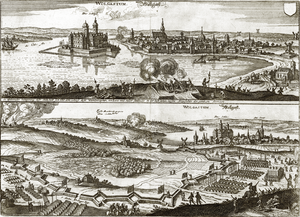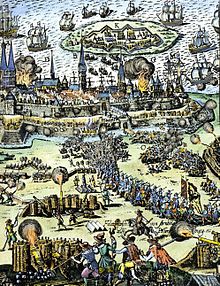Battle of Wolgast
| date | September 2, 1628 greg. |
|---|---|
| place | Wolgast , Pomerania |
| output | Imperial victory |
| consequences | King Christian IV flees to Denmark |
| Parties to the conflict | |
|---|---|
|
Protestant Denmark |
|
| Commander | |
| Troop strength | |
| 7,000-8,000 | 7,000 total 5,000–6,000 involved in the battle |
| losses | |
|
1000 dead |
680–1000 dead, approx. 1100 prisoners |
In the Battle of Wolgast during the Thirty Years' War in the phase of the Danish-Lower Saxon War , on September 2, 1628, the imperial troops under Wallenstein defeated the Danish defenders of the city under King Christian IV.
prehistory
Christian IV, King of Denmark began a Danish intervention in the Thirty Years' War in 1625. Successful at first, the fortunes of war turned after the Danish defeats in the Battle of Dessau and the Battle of Lutter in 1626.
The imperial military leader Wallenstein previously besieged the city of Stralsund , which was considered impregnable, unsuccessfully from 23 May to 28 July . He broke off the siege three days after the arrival of King Christian IV with 100 ships and 8,000 men on board. The Danish king left a garrison in the Hanseatic city, which officially belonged to Pomerania, which he then ceded to the Swedes after the imperial withdrawal. The Danish king, encouraged by this success, tried to transfer his sea-based tactics to another landing in Usedom.
Therefore, King Christian IV left the coast of Rügen with his fleet and landed with 7000 men on August 21, 1628 greg. on the Pomeranian island of Usedom at the mouth of the Peene , occupied by imperial troops , conquered the Peenemünder Schanze , as well as the cities of Usedom and on August 24th Wolgast after a brief resistance. He then holed up in Wolgast, with the aim of reaching another Stralsund . Since General von Arnim was sick, Wallenstein hurried from Mecklenburg to Pomerania and gathered 6 regiments of infantry and 22 squadrons of cavalry and 11 cannons, a total of 7,000 to 8,000 men, at Greifswald , whereby he remained inactive and waiting, hoping that the Danes would come would move from the coast covered by the fleet. When the danger of Swedish reinforcements increased, Wallenstein advanced against Wolgast. The Danish entrenchments that were made in the meantime were not yet completed at this point.
course
The battlefield chosen by King Christian IV was half a mile west of Wolgast and was covered by the coast and marshes , which by then had dried up. Notwithstanding this, the first attack by the imperial troops was averted by the Danes with great losses for the imperial. During the second attack, the Danish infantry fell back into the unfinished entrenchments, but the attack was repulsed again by a relief attack by seven Danish cavalry squadrons. During the third attack, the Danes' lack of ammunition became noticeable, so that they had to retreat within the city walls under cover of the cavalry. The Danes had resisted the attacks from noon to 7 p.m.
consequences
On that day the Danes lost 500 infantry and 180 horsemen to deaths and many prisoners. The losses of the imperial are said to have been around 1,000 dead. To secure his retreat, the Danish king had the supplies in Wolgast destroyed and returned to Denmark with the rest of the army and fleet. Wallenstein then moved into Wolgast. This victory prevented Wallenstein from being recalled by the emperor after the failure at Stralsund.
For the Danish king, the defeat meant the end of hopes to turn this war around. Although the Danish army attempted to land near Neustadt in Holstein in mid-October, this failed too. Then Denmark's last possessions in Holstein were also lost. In January 1629 the peace negotiations began in Lübeck, which ended in mid-June in the Peace of Lübeck , which marked the end of the Danish-Lower Saxon war.
The Swedes began the invasion of Germany as early as 1630. They landed on Usedom near Wolgast, just as the Danish king had done before.
literature
- Theatrum Europaeum . Volume 1. pp. 1089-1090.
- Friedrich Rudolf von Rothenburg : Battles, sieges and skirmishes in Germany and the neighboring countries. Volume 2: 1618 to the end of 1632. 3rd edition. Hirschfeld, Vienna 1835, pp. 160–161.
- William P. Guthrie: Battles of the Thirty Years War. From White Mountain to Nordlingen, 1618-1635 (= Contributions in Military Studies. Vol. 213). Greenwood Press, Westport CT et al. 2002, ISBN 0-313-32028-4 .
Individual evidence
- ^ Guthrie: Battles of the Thirty Years War. 2002, p. 144.
- ↑ Wolfgang Reinhard, Rolf Häfele (Ed.): Handbook of German History. Volume 10: Confessional Age 1555-1618. Thirty Years War 1618–1648. 10th completely revised edition. Klett-Cotta, Stuttgart 2001, ISBN 3-608-60010-8 , p. 229.
- ^ Guthrie: Battles of the Thirty Years War. 2002, p. 143, (The German literature from the 19th century gives lower values).
- ^ Guthrie: Battles of the Thirty Years War. 2002, p. 144.
- ↑ Josef Kollmann (ed.): The Danish-Low German War and the rise of Wallenstein. Sources on the history of the war events from 1625–1630 (= Documenta Bohemica bellum tricennale illustrantia. Vol. 4). Academia et al., Prague et al. 1974, ISBN 3-205-00510-4 , p. 19.

